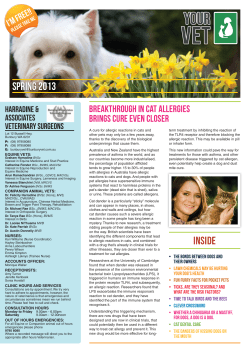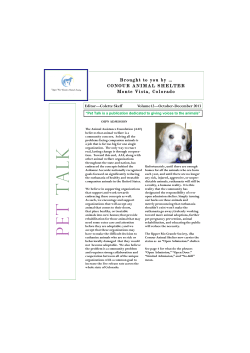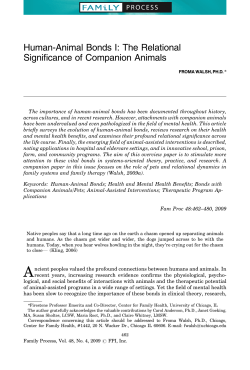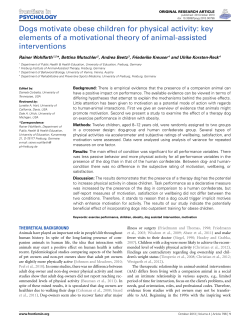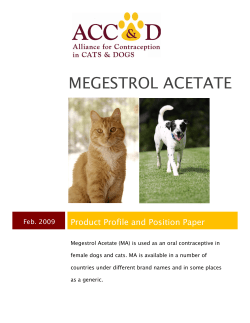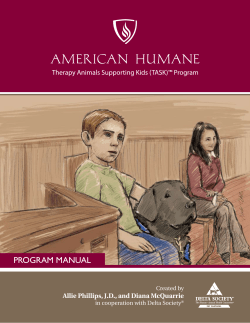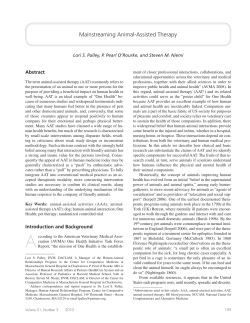
Animal-Facilitated Therapy in Various Patient Populations Systematic Literature Review Sarah Matuszek, MSN, RN
F E AT U R E S Animal-Facilitated Therapy in Various Patient Populations Systematic Literature Review ■ Sarah Matuszek, MSN, RN With a soaring trend of the incorporation of complementary therapies into the mainstream of health care, animal-facilitated therapy has become a popular interest for the health care team to integrate into a patient’s plan of care. This systematic literature summarizes the current research on the use of animal therapy in several patient populations and provides nursing implications for practice. KEY WORDS: animal-assisted therapy, human-companion animal bond, nursing and pet therapy, pet-facilitated therapy Holist Nurs Pract 2010;24(4):187–203 I cannot talk. I have 4 legs. I have paws. My claws may intimidate you. I wag my tail when I am happy. I whimper when I am sad. At last, I have arrived and I am here to help you. Pet me and you will smile. I will calm you. I will help you forget the bad things, yet I’m here to help you remember the good things in life. I won’t offer solutions; I will just listen. All I have are gestures. . . . I am a therapy dog. Pets are truly nonjudgmental and love unconditionally. Their love to give to others fails to weaken and is everlasting. Their lifetime of loyalty and companionship for humans is undeniable. Specifically in nursing, “pet therapy” is becoming a heightened and rewarding trend for hospitalized and chronically ill patients and gives a tremendous amount of comfort to them. The use of pet therapy in nursing is now known as animal-facilitated therapy, which is an umbrella term that covers animal-assisted activities (AAA) and animal-assisted therapy (AAT). Animal-facilitated therapy has existed since the 1800s, when Florence Nightingale made substantial discoveries, especially regarding animal therapy.1,2 She once recommended that animals are good companions for the infirmed.1,2 Since Nightingale’s suggestions and from past discoveries, the profession of nursing recently began implementing the use of animals as therapeutic interventions; the use of dogs has been used to assist Author Affiliation: Lourdes College, Sylvania, Ohio. Correspondence: Sarah Matuszek, MSN, RN, Lourdes College, Sylvania, Ohio (Sarah.Matuszek@mercycollege.edu). patients’ emotional, psychological, and physical well-being. Such benefits of therapy dogs include a decrease in loneliness, stress, blood pressure, and heart rate,1 which all contribute to the improvement of patient outcomes.1 Animal therapy uses animals, mostly dogs, to aid in healing patients holistically. Dogs have an overwhelming gratitude and exuberance for life and this effect on people is astounding. Furthermore, animal-facilitated therapy has been researched and its effectiveness on patients’ outcomes and healing is documented, yet it continues to be a standing controversial topic in nursing and health care. SIGNIFICANCE TO NURSING Regardless of when a therapy dog steps on a hospital ward, it is irrefutable that the majority of the staff and patients develop a smile in interest. Nurses who utilize a therapy animal in their practice recognize this and consider a smile or act of engagement a success. In a meta-analyses performed by Souter and Miller,3 the 5 articles they analyzed showed that AAA/AAT had positive effects on depression. However, they also noted that the implementation of animal-facilitated therapy in nursing created various legitimate concerns and controversies. Skepticism of therapy dogs revolves around fear of animals transmitted diseases to humans and the risks of dog bites and scratches.4 The therapeutic purpose of using animals by nurses in health care is considered complementary therapy. 187 188 HOLISTIC NURSING PRACTICE · JULY/AUGUST 2010 Complementary medicine is based on the paradigm of whole systems.5 The belief is that people are more than physical in nature, rather their well-being is composed of many components such as mental, emotional, and spiritual.5 These all interact with each other and are part of a force of life.5 Much complementary therapy is inherited from Eastern medicine and has joined the Western culture. AAA/AAT is becoming one of many new complementary therapies that are used in nursing to assist patients with their infirmities and deficits. In nursing, the use of AAA/AAT is increasing; however, the research on the effectiveness of this therapy in various health care settings continues to lag behind. WHAT IS ANIMAL-FACILITATED THERAPY? Animal-facilitated therapy involves using any animal for the purpose of providing emotional support only.5 Dogs, cats, guinea pigs, rabbits, and horses are some of the kinds of animals that have been used as therapy for humans. The most common therapy animal is a therapy dog. Therapy dogs are strenuously trained and evaluated on special commands and good behavior. Therapy dogs must know commands to sit, stay, lie down, and come.6 Once a dog is sufficiently trained, the dog can then be evaluated by a licensed evaluator. The dog must pass a series of commands and tasks in order to become certified by the American Kennel Club (AKC) as a therapy dog. Therapy dogs are used by the health care team as a therapeutic modality in order to gain insight into thought and emotional/ behavioral patterns.6 Therapy dogs help improve the social, mental, and physical conditions of patients.6 Once a dog is certified, proper vaccination and health requirements must be completed. After the paperwork is processed, the therapy visits can begin. Several rules and regulations must be adhered to as a therapy dog owner. For example, prior to any visit, the dog must be bathed within 24 hours and must have clean teeth, trimmed nails, and clean ears.6 This ensures that the dogs are in proper hygienic condition to make a visit. Several other rules exist that must be followed as well. Animal-assisted activities and animal-assisted therapy AAA and AAT can be separated from each other on the basis of the intent and goal of each. The Delta Society, one of the most renowned professional dog therapy organizations, defines AAA as “. . .the casual ‘meet and greet’ activities that involve pets visiting people. The same activity can be repeated with many people, unlike a therapy program that is tailored to a particular person or medical condition.”7 For example, a pet that visits a patient in the hospital without a specific goal would be considered an AAA. On the other hand, AAT is defined as “. . .a goal-directed intervention directed and/or delivered by a health/human service professional with specialized expertise, and within the scope of practice of his/her profession. AAT is designed to promote improvement in human physical, social, emotional, and/or cognitive functioning.”.7 Thus, the patient’s goal should be monitored and progress should be documented when AAT is used as an intervention. Both of these animal therapy components can provide positive outcomes for a patient. Regardless of whether AAA or AAT is used, the use of animals can be beneficial and supplemental to a patient’s plan of care. Purpose of the literature review The purpose of this systematic literature review is to summarize, stratify, and categorize the literature based on animal-facilitated therapy within nursing. The integration of animal therapy into nursing practice within various patient populations (nursing homes and rehabilitation, hospice, psychiatric, and pediatric wards) will be investigated. In addition, the realm of nursing practice will be explored to analyze how animal therapy as complementary therapy can be included in the care for various patient populations. This literature review will describe (1) animal-facilitated therapy; (2) the history, (3) benefits, (4) risks, (5) and types of animals used for therapy in the past; (6) different settings that animals have been used; and (7) the significance of the human-animal bond. The significance and objective of this review is to describe current use of this therapy in nursing and to introduce the use of animal therapy as an alternative intervention for many patients to nurses who are not aware of its benefits. Animal-facilitated therapy can complement the current treatment a patient is receiving; it is currently recommended and used in several health care settings. Research questions 1. How has health care integrated pet therapy into the care of patients? 2. How has nursing practice integrated pet therapy? Animal-Facilitated Therapy 3. What are the documented benefits of pet therapy in patient outcomes? Theoretical framework Healing the whole person is the focus of the holistic nursing model.5 Integrating animal-facilitated therapy into the healing process of the human body is essential for nurses and other health care providers. Animalfacilitated therapy helps to encompass therapeutic interventions for patients’ mind, body, and spirit.5 When an animal interacts with a human, that person’s mind becomes occupied in the moment. A patient may recall a memory or help to envision the future. The person is no longer focused on his or her pain, sadness, illness, or disease, but an animal helps to bring the mind, body, and spirit on the present moment. The touch of an animal increases the release of endorphins in order for the body to relax.5,8-10 The spirit of a person is then able to interact with the mind and the body to establish a serene state. Animal-facilitated therapy promotes a healing environment for patients and involves a holistic and humanistic perspective. If a patient is upset because he wants to be home to take care of his 2 cats, there is no pill that will allow him to do so. An alternative method would be for the nurse to allow a pet or animal therapy visit for the patient to ease his mind. Animal-facilitated therapy can be one of the many strategies nurses can use to benefit their patients. The nursing meta-paradigm includes 4 separate concepts: the person, environment, health, and nursing. The ability to interconnect these with the mind, body, and spirit represents a unique and holistic way of caring. Methodology The selection of databases for electronic searches was based on the literature provided and on the search criteria. The following computerized databases were utilized: EBSCOhost, CINAHL, OhioLINK, Nursing and Allied Health, and MEDLINE. Each of these databases provided peer-reviewed research literature in nursing and/or health care. Key terms used in the searches included the following: nursing and pet therapy, AAT, AAA, pet-facilitated therapy, and human-companion animal bond. After the initial search and review of literature regarding “pet therapy in nursing,” animal-facilitated therapy was deemed to be a more proper term. 189 Initially, to find what type of literature existed, entering “pet therapy and nursing” as the key words yielded a total of 173 citations. Of the 173 articles, many were summaries/reviews, editorials, and anecdotal papers that did not meet criteria or data that could be analyzed. An additional search of “animal therapy in nursing” was conducted to include only peer-reviewed research between 1999 and 2009. A total of 134 articles were examined and only 14 articles met inclusion criteria. Books focused on animal therapy were also used by the researcher to supplement the computer and Internet searches. Two books were guidelines and standards of practice for the use of animal-facilitated therapy in nursing. A few unpublished manuscripts were discovered but not used for this literature review. The basis of this systematic literature review was to examine the effects of animal therapy on patients in various nursing care environments and to discover implications that nurses can use in their care. In order to be included in this review of literature, each study was required to meet several criteria. The inclusion criteria was that (1) the literature had be relevant to nursing and animal therapy, (2) the articles were peer-reviewed, (3) the study was published between 1999 and 2009, and (4) effects of animal-facilitated therapy on various patient populations were mentioned. A table was created to summarize the data from the literature that was reviewed (refer to the Appendix). Identifying and reviewing only the “highestquality” literature was the main priority. The research articles were selected and critiqued based on the author providing an abstract, introduction, background, framework, methodology, results and discussion sections. Each section had to be mentioned thoroughly and used appropriately in order to qualify. First, the introduction and background had to be clear and concise and define the problem. Second, the problem statement needed to be clear and narrow enough to study. Third, a conceptual or theoretical framework that guided the study needed to be mentioned and relate to the problem. Each research study described and utilized the methodology adequately and they appropriately identified the statistical significance and type of research design. Fourth, the results of the study were summarized based on the analyses. Finally, the discussion of each article mentioned the overall results of the study, the rationale for any significant or nonsignificant result, the limitations of the study, and implications for practice. The Appendix illustrates a 190 HOLISTIC NURSING PRACTICE · JULY/AUGUST 2010 table that summarizes the author(s), characteristics of the study, and a description of the results that involved the use of animal therapy for patients. Because reliability and validity are the cornerstones of scientific research, they were established in several ways. Reliability of this literature review was established by ensuring the research studies were properly performed and by evaluating the use of measurement tools that were used. For example, a few of the studies used the same measurement tools such as the Geriatric Depression Scale, which aids in the generalization of data. This scale measured depression consistently by yielding similar results in each study. FINDINGS Historical overview The first use of therapeutic use of animals began during the ninth century in Belgium for handicapped people.1,8,9 The people were assigned the task to care for different farm animals.8,11 Again, later in the 1700s the York Retreat in England utilized animals.4,8,12 This was not a typical mental institution for its time. During the 1700s, asylums were used to institutionalize mentally insane patients until they died in residency. William Tuke, a Quaker who founded the York Retreat, began to question the appalling treatment of the mentally unstable and disturbed people.8 He decided to change the treatment and implemented many experimental interventions for the patients. The York Retreat permitted inmates to wear their own clothing, engage in handicrafts, and to write and read. They were allowed to wander freely around the courtyards that had several domestic animals such as rabbits, seagulls, and hawks for the patients as a means to promote patient well-being and encouragement.4,8 This was considered positive rather than punitive care because these animals provided not only innocent pleasure but also a means for the patients to communicate to another living being and to initiate socialization and benevolent feelings.4,8 Later on, the use of animals was initiated in Germany where farm animals such as sheep, horses, and monkeys were used for the care of patients with epilepsy.4,8 It was noted that this intervention would “create a more pleasing and less prison-like atmosphere.”8(p13) It was documented that the women were observed to be cheerfully enlightened and the men were found pouring out their woes to the dogs and cats.8 Animals have been used for patients for a long time and positive benefits have been documented. Nursing’s first use of animal-facilitated therapy in the United States can be traced back to the historical days of Florence Nightingale. In her writings, she commented on the benefits of animals with patient care and recovery. She stated that a small pet “is often an excellent companion for the sick, for long chronic cases especially.”8(p13) In fact, she had a pet owl named Athena. Nightingale stated, “A pet bird in a cage is sometimes the only pleasure of an invalid confined for years to the same room.”2(p18),8(p13),11(p46) Throughout the history of the United States, animal therapy existed within the Army Air Corps Convalescent Hospital in New York.8 It was used with psychiatric patients and recovering veterans. The soldiers who were wounded or suffering from fatigue were encouraged to work on the farm with the cattle, hogs, horses, and poultry.4 In 1970, a survey regarding how many facilities used animals as therapy was conducted. A stunning 48% of the participants reported using animals in one way or another for therapy.12 Mostly, these historical accounts of using animal therapy were documented; however, very little empirical research was performed to support the effects on patients. The Dog as a Cotherapist Animal therapy became very popular in the 1960s.2 Dr Levinson embarked on research of animalfacilitated therapy and children.2 He was a psychiatrist who used a dog to facilitate work with a child client.2 His discovery came before one of his appointments with a mother and her disturbed and nonverbal child.2 They arrived early for their scheduled appointment and Dr Levinsion brought his dog named Jingles to the office with him. At that time, the disturbed young boy interacted with Jingles like he never did with his doctor or family. Dr Levinson realized the benefit of using his dog as a strategy to bridge communication with his patients.4,12 As a result, Dr Levinsion published a book, The Dog as a Co-therapist, noting the positive interactions between the child and his dog. 4,8,12 The expansion of further research has multiplied within the field of psychology. Eden Alternative The most current research on animal-facilitated therapy began in the 1990s by Dr William Thomas; he Animal-Facilitated Therapy created the Eden Alternative.6,8,13 Dr Thomas discovered the 3 major problems within nursing homes were loneliness, helplessness, and boredom.2,6,8 Sometimes nursing homes do not have the characteristics of a person’s home; rather they are more of an institution. The purpose of the Eden Alternative was to change and transform health care facilities into human habitats that can provide shelter and love within their walls.2 Dr Thomas decided to use animals, plants, and children to interact with the residents. With these interactions, relationships among the patients, their families, and the staff were enhanced. In a research study that used the Eden Alternative as the framework for animal therapy found that it improved the mood of nursing home patients.6 Today, the Eden Alternative is being used in Extended Care Facilities (ECFs) throughout the United States in states such as New York, Ohio, North Carolina, and Missouri, Australia, and New Zealand5 ; many positive outcomes have been found and the trend continues to spread. Human-companion bond Currently, 60% of households in the United States have pets.2(p19) There are more than 72 million pet dogs and nearly 82 million pet cats in the United States.13 The majority of pet owners treat their pets as family members.13,14 In Westernized society, dogs have many different roles. They are pets, companions, therapeutic interventions, assistance, and service animals.15 Despite the role of pets, bonding exists mutually and is a very interactive process. Bonds are characterized by attachment, emotions, affection, and trust. According to the American Veterinary Medical Association,16 “The human-animal bond is a mutually beneficial and dynamic relationship between people and animals that is influenced by behaviors that are essential to the health and well-being of both.” Interestingly enough, as humans we tend to humanize our pets. We name them, we speak to them, we include them in our families, we put clothes on them, and we love them as if they were humans. This displays the human-animal bond. This bond is believed to reduce blood pressure, heart rate, loneliness, and cholesterol in people.1,17 Animals are used to help the handicap, mentally challenged, prisoners, elderly, infirmed, and children.5,6,8,14,17-32 Animals are leaders of social 191 facilitating and develop a therapeutic rapport for patients.8,9,12 People engage and talk to animals as if they are humans. In many cases, this may be therapeutic for patients and help them relax to decrease their anxiety. In a case of a hospitalized woman who was severely injured in an automobile accident, she became depressed and easily agitated.33 She was not responding to the staff’s efforts to comfort her. Her parents mentioned that she missed her pet dog. The animal therapy staff made a visit to her and with subsequent visits, she improved her mood, balance, and strength.33 The prevalence of animal-facilitated therapy throughout various health care settings exists not only in the United States of America but abroad as well. In a global survey conducted by the American Veterinary Medical Association,16 the human-animal bond was perceived to be greater in more prosperous nations such as the United States, Canada, Germany, and England. In less developed countries, the human-animal bond is much weaker because animals are valued less as a family member but more for their utility.34 Animals are not as respected because people may not be economically stable to care for them. Health care providers need to be aware of the cultural norms of their patients because they may not value the human-animal bond. The attachment between a human and an animal is remarkable and valuable. The relationship within the human-animal bond involves a dog giving unconditional love, having nonjudgmental loyalty, and having the role of being a confidant.1,5,8,12 The daily care, comfort, socialization, and motivation all create a bond that is beneficial and perpetual. Therefore, animals and pets represent an unselfish and influential relationship that partially depends on the human species.1 It is important to note the facilitation of the multidisciplinary team because many different disciplines have contributed to animal bonding and animal therapy. Discovery of the human-animal bond concept was brought about mainly by social workers who developed and implemented many therapy animal programs.1,12 With this research, other disciplines such as nursing have continued to expand their practice and research in the use of animal therapy. Nursing, pet therapy, and the patient Nursing can be defined in various ways. One of the most vital roles and responsibilities of the nurse is to 192 HOLISTIC NURSING PRACTICE · JULY/AUGUST 2010 be a patient advocate. Advocating involves providing support for the patient’s best interests. By advocating, the nurse addresses the patient’s physical, emotional, and psychological aspects. In any clinical health care setting, it is possible for the nurse to advocate by encouraging and integrating the use of animals as a therapeutic intervention. Animal-facilitated activities AAT is used as a treatment modality within health care settings. Hume,9 a licensed practical nurse, developed an animal therapy program for patients in physical rehabilitation programs. Examples of activities used are throwing an object for a dog to retrieve; this involves releasing and reaching for that same object when the dog retrieves it, and it helps to increase coordination.8,9 An activity to increase range of motion in the upper extremities, brushing, stroking, or throwing an object for the dog to retrieve will contribute to build muscle strength.5 Some therapies are considered active and others passive. Active activities involve patients performing a task independently without any assistance.9 On the other hand, passive activities require assistance in completing a task.9 Hippotherapy can also be a passive or active therapeutic activity for several people; this therapy involves riding a horse.8,9 Each time a person takes a step, the pelvis tilts higher, sideways, forward, and then back.9(p129) Because of the similarity between a horse’s gait and a person’s walk, riding a horse resembles the motions of walking without actually placing weight on the legs.8 The regularity of the movement of a horse aids in building posture, strength, balance, and mobility. Patients with disorders such as multiple sclerosis, cerebral palsy, spina bifida, and autism are examples that equestrian therapy may help.9 Benefits of riding a horse include increased flexibility, gross motor coordination, and speech and language abilities.8 A study of 32 spinal cord injury patients used repeated sessions of hippotherapy and the spasticity of their lower extremities was reduced.8,9 Supplemental research demonstrates the improved gross motor function and energy in children with cerebral palsy who used hippotherapy.8,9 Service dogs Service dogs serve as assistance animals for people who are physically, mentally, and/or emotionally disabled.9 Service dogs can be any breed and are specially trained to assist people to complete their daily activities, self-care, and for any other needs the person may have. These dogs are the disabled person’s partner and go everywhere with him or her, including to the store, on an airplane, or the hospital. According to the American Disabilities Act, this law allows service dogs to be brought into public places. The dogs are properly identified by wearing a vest and are certified. Benefits of animal-facilitated therapy Animal-facilitated therapy has been researched and findings from these studies showed that physically touching a pet decreases blood pressure, anxiety, stress, and hopelessness.12,20 A study that tested the effects of using a fish tank in a dentist’s office revealed a reduction in anxiety.11 Touching an animal can help to foster trust and cognitive functioning and to decrease stress and anxiety in humans.5 In general, animal-facilitated activities are used in patients with cardiovascular and psychiatric disorders.19 In the most known study by Friedman and Thomas,19 the influences of pets were investigated with patients who experienced a myocardial infarction. They compared the survival rates of pet owners versus non–pet owners. This study involved 424 randomly selected men and women. The results revealed that there was no statistically significant difference (SSD) between pet ownership and 1-year survival. However, a trend showed that dog owners were more likely to be alive 1 year after their heart attack.19 A study20 conducted on a rehabilitation unit for geriatric patients examined the responses of patients who interacted with caged birds. An increase in attention span was found because patients left their rooms more frequently to visit the bird.20 The patients became more positive and curious and had a personal desire and commitment to care for the birds.20 The birds provided a unique source of conversation for the patients and made them feel wanted, which ultimately gave them a purpose in their life.20 Animals appear to help shift the focus off the patients’ symptoms of illness by distracting them from their current situation and helping them relax in order to improve their overall well-being. It has been known that the therapeutic touch of an animal develops a sense of serenity and tranquility and influences one’s mood.10 Animal-Facilitated Therapy Moreover, a weak immune system can be a barrier to receiving an animal therapy. In some circumstances, an animal may compromise an immunosupressed patient and this causes harm.8,9 In previous years, people with compromised immune systems were advised to give up their pets. The fact is that “. . .people are more likely to contract zoonotic infections from contaminated food, water, soil, or even other people than from pets.”5(p456) Perceived risks of animal-facilitated therapy Common concerns exist regarding the use of animals in the health care setting and must be examined when considering the use of animal therapy. These issues must be weighed against the benefits to determine when to use the therapy appropriately. Many of the patients, staff, and public all have basic concerns and hesitations about using animal-facilitated therapy because some health care providers think that fear and anxiety could increase when someone is not comfortable with animals such as larger-breed dogs. Patients may not want an animal in their room because of their fears.4 Some of the common concerns are allergies, cultural beliefs, infection, and liability.6,8,9,35 Allergies are common and might stress the immune system in some patients.6,8,9,35 If a patient or staff member is allergic to pet dander or fur, this therapy would be contraindicated and they would not be able to experience this use of animals. However, it has been noted that only 6% of people seen by allergists have an allergic reaction due to animal dander8,9 As a result, these issues must be addressed during admission data collection and with each facility before implementing animal therapy. Moreover, a person’s attitude and culture may not approve or accept animals as a complementary therapy.16,34 For instance, the Middle Eastern and Southeast Asian cultures consider dogs as unclean or a nuisance.16,34 In patients who hold these beliefs, animal therapy would not be an option. Therefore, cultural beliefs need to be considered before implementing animal-facilitated therapy. Another major concern is pet-associated zoonosis,4,917,35 which is the ability of animals to transmit and carry diseases to the human species.4,9,17,35 Animal therapy may increase the risk of infection transmission by disrupting the aseptic environment of a medical facility.4 There are wide arrays of disease classifications such as viral, bacterial, and parasitic that have the potential to be 193 contracted from animals to humans.35 Most of the diseases require an actual scratch or bite from a dog. Scabies, fleas, and ringworm can be spread through direct contact.35 This is controversial and some may argue that hospitals are known for their lack of sterility because it is a place where people are very ill, and bacteria and viruses are widespread. Each hospital has its own standards when animals visit. Many hospitals require that a pad or towel be placed on the bed for the animal to lie on. In isolation rooms, animals are prohibited to prevent the transmission of methicillin-resistant Staphylococcus aureus, vancomycin-resistant Enterococcus, or other lethal bacteria.35 Another concern is liability of having an animal in a health care facility. Animal bites pose as a major health hazard.35 Therapy animals must have proper temperaments and dispositions. Therapy dogs are certified only if they meet proper behavioral requirements. It is not safe to claim that therapy dogs do not bite because any animal can bite regardless of the training. Rather it is preferred to reassure a patient that the animals are certified. Therapy Dogs International provides liability insurance if any incident occurs.6 If appropriate measures, cautions, rules, and regulations are followed, the use of pet therapy should not affect the liability risk or the transmission of diseases in a health care facility. Animal-facilitated therapy in various health care settings Animal-facilitated therapy is concurrent with traditional treatment plans in many different health care populations and settings. For example, University of California at Los Angeles Medical School investigated hospitalized cardiac disease patients.9 Their reactions from visits by a dog team, a human, or no visit by anyone were measured.9 Compared with the group of patients that had no visit at all, the group that received visits from a therapy dog confirmed there were influences on cardiac function and changes in mood and neurohormone levels.9 Mostly, in the group that received visits from the therapy dog, the anxiety scores of the patients compared with both control groups were decreased.9,36 Extended care facilities and rehabilitation centers and hospice, psychiatric, and pediatric wards have been known to use animal therapy.1,8,9,12 Animal-facilitated therapy can be used for individuals or a group of people. Within these settings, animals 194 HOLISTIC NURSING PRACTICE · JULY/AUGUST 2010 are a key component to a 2-way conversation.12 In the community, physicians can prescribe to their patients, pets as companion animals or visits from a therapy dog.12 When a physician prescribes this, the goal is to combat loneliness, emotional problems, a sedentary lifestyle, and stress.1,6,8-10,12,28,36 Alternatively, if animal-facilitated therapy is present in her facility and depending on the protocol, a nurse can either suggest to the physician or call the therapy dog team if the patient has the potential to benefit from this complementary therapy. Hospitalized patients In a study24 that investigated the use of AAT in hospitalized patients with heart failure, the patients’ hemodynamic values, hormone levels (norepinephrine and epinephrine), and anxiety levels were all measured. In comparison with the preintervention and postinterventions, results showed an overall decrease in cardiopulmonary pressures, neurohormone levels, and anxiety in the group that received a visit from a therapy dog.21 This showed how beneficial animal-facilitated therapy is in critically ill patients. In pediatric patients who experienced animal therapy, significant differences in happiness, positive mood, and an increase in positive interactions of the children were discovered.22 The pet therapy group had sessions 1 night per week. And each child was video taped during and immediately after each therapy session. After hospitalized children received an animal visit, pain scores were measured and were found to decrease significantly (P < .006).24 Parents also perceived more positive mood after the pet therapy sessions.24 In addition, one study that explored the effects of therapy dogs in children with pervasive developmental disorders revealed an increase in happiness, playfulness, energy, and interactions.24 Psychiatric population In patients with psychiatric disorders, the use of animal-facilitated therapy has been implemented as well.6,9,25 For this population, animal therapy can be used to improve a person’s mental status by increasing socialization, behavior, and motivation, or by providing a sense of purpose.6,9-33 Animal therapy can help depressed patients by promoting humor and providing unconditional acceptance.9 During group therapy sessions, therapy dogs can help patients decrease anxiety, increase attention span, and remain calm.25 It has been found that AAT has influenced prosocial behaviors such as interaction, pleasure, and smiling in patients during psychiatric rehabilitation.25 It is important to note that not all psychiatric patients will benefit from animal-facilitated therapy, especially those who are mentally incapacitated and are unable to respond to animals. A study that investigated the anxiety levels of 230 hospitalized psychiatric patients and the effects of an AAT session compared with a recreation session revealed a significant reduction in anxiety levels for patients with dual-diagnosis mental disorders.5 Moreover, in a study of emotionally disturbed children, regular visits from a therapy dog contributed to significant improvements in behavior and attendance.9 Depression in elderly patients is a very common psychiatric disorder. One study investigated the effects of pet-facilitated therapy on depression and mood in ECFs.4 The experimental group had visits from therapy dogs and the control group had visits from people. Results showed an SSD (P < .001) on the mood scores; however, there was no SSD with the depression scores in the experimental group.4 Overall, this study showed a positive effect of therapy dogs on the moods in long-term residents. Nutrition is typically decreased in patients with Alzheimer disease. One study26 found significant results with the use of aquariums with live fish. While observing the fish, patients with a history of pacing and wandering were able to focus while sitting for longer periods of time.26 These patients significantly increased their nutritional intake during and after they were exposed to the aquariums (P < .001).26 Overall, 87% of the participants in the experimental groups increased their dietary intake.26 Many of the participants continued to gain weight after the study was finished. Communication can be challenging in patients who have Alzheimer disease. A study27 that compared the effects of toy versus live animals on verbal communication in patients with Alzheimer disease found positive outcomes. There were three 10-minute sessions in which an observer recorded the participants with a video camera.27 First, the participants surrounded a table without any intervention.27 Depending on what group they were in, during the intervention phase, 2 toys (group 1) or live cats (group 2) were placed on the table; the reactions Animal-Facilitated Therapy 195 of the participants were taped.27 After each session, the scores of the participants were totaled.27 Those patients who experienced a live cat instead of a toy cat increased their total words per minute, word initiatives, and meaningful information units. Another interesting finding was an increase in touch of the live cats observed in the patients.27 pets.”9(pp71-72) A research study involving companion animals for people with HIV/AIDS found several themes among their research, including having affection, having companionship, feeling valued, having source of support, and helping to focus on the present.37 These people perceived their pets as lifelong companions. Palliative care Correctional facilities Animal-facilitated therapy can prove to be beneficial in a few types of palliative care areas such as hospice and the human immunodeficiency virus/acquired immunodeficiency syndrome (HIV/AIDS) populations.8,9,28,29 In hospice care, therapy dogs make a visit to the patients who are facing their final stages of life. AAA is used primarily for patients who are dying because animals provide comfort and love. According to Therapy Dogs International,28 “The sight of our dogs and the touch of their fur often bring peace and joy to those patients whose life once included animals. Physical contact has a calming effect and dogs have the ability to bring back pleasant memories of a person’s life. Therapy dogs help combat loneliness and they give people the chance to have something to look forward to. Exposure to our dogs allows the patient to feel needed and wanted at a time in their life when death is evident.”28 For example, families may request that a therapy dog lay at the end of the patient’s bed during one’s last breaths of life. This allows the patient and family to be comforted by the dog.28 One study29 investigated the effect of AAA on mood, self-perceived health, and sense of coherence among patients with cancer. The first group had dog visits, the second group quietly read, and the third group had a visit from a friendly person.29 The group with a dog visit had a decrease in fatigue scores.29 “Health was rated as significantly better compared to others their age for the human visitor group, but the dog visit group rated their health better than those their own age at no SSD (P = 1.00).”29(p229) Currently, there are an estimated 45% of Americans with HIV/AIDS who own pets.8 These people are encouraged to own a pet. With considerations on their immune status, proper precautions can allow a patient with imunosupression to still be able to care for a pet. In some circumstances, people “. . .with AIDS may be abandoned by friends and relatives and the most consistent physical contact that remains is their Correctional institutions also have positive influences from therapy animals such as birds, fish, rabbits, and guinea pigs.4,12 One study showed that the attitudes of inmates changed along with an improvement in communication among the staff.8,9 Rehabilitation programs for inmates allow them to entirely care for shelter animals including feeding, bathing, grooming, and training them.9,30,31 The ultimate hope was for the inmates to become more productive citizens once released. Concurrently, in the early 1900s, the largest animal therapy operation occurred in the Lima Ohio State Hospital that housed 375 convicted inmates.8,12 Here, fish, birds, and gerbils served as companions for the inmates.12 Presently, several correctional facilities throughout the United States collaborate with local or state humane societies for the inmates to train the dogs. For example, the Inmate Dog Alliance Project of Idaho30 involves temporary placement of dogs with inmates to socialize and train them. Each inmate interested is screened for good behavior and various other factors are taken into consideration. At completion, many of the dogs are used as assistance and service dogs. This program not only helps sheltered dogs but also teaches the inmates the values of responsibility, persistence, and empathy.30 Another organization named Puppies Behind Bars trains inmates to train service or law enforcement dogs.31 One of the main human benefits of this program is for the inmates to receive and to give unconditional love to the dogs. It also allows them to contribute to society despite their history.31 War veterans Veterans can experience psychological, emotional, and physical disruptions as the result of war. There are still several million veterans of World War II, Vietnam, Korean, Persian Gulf, and Iraq and Afghanistan wars. Although the actual war the veterans 196 HOLISTIC NURSING PRACTICE · JULY/AUGUST 2010 were in may be over, the war within them still exists. Posttraumatic stress disorder (PTSD) is common in almost every soldier who returns from war. The use of animal-facilitated therapy in veteran hospitals is becoming more apparent. It is being used especially for psychological and physical injuries of the injured. Equine therapy uses horses to help veterans emotionally and personally.38 The veterans have to care for the horses, can ride them, and communicate with them.38 These activities help build assertiveness, responsibility, and confidence.38 In addition, parrots are being used to help veterans with PTSD.38,39 Because of the horrible effects of PTSD involving social and living capacity of veterans, interacting and caring for parrots and other birds help to establish a medium to rebuild their lives and to be able to function better.31 Recently, the Department of Defense has provided funding to investigate the use of animal-facilitated therapy for Iraq and Afghanistan war veterans.16,34,38 Nurses can help physically disabled veterans by working with them to develop basic activities of personal care such as brushing teeth, getting dressed, and eating.31 Geriatrics Animal-facilitated therapy greatly benefits assisted living and nursing homes. Specifically, dog visits are usually in a group activity.28 In most cases, a group of therapy dogs will gather in a room or large area and if the residents would like to interact, they can do so by attending the session.6,28 One study32 examined the effects of dog visits on depression, mood, and social interaction in elderly people. Little improvement and impact on depression and mood after receiving dog visits was found. However, a positive effect on social interaction was noted. Furthermore, all of the participants reported that the dog visits made them feel happy.32 Special requests for the therapy dogs to visit an apartment are considered if a resident is incapable of attending the session. “Therapy Dogs help to involve the elderly to live a happy, productive life by filling a need that is not being addressed in any other way. Residents often look forward to the dogs visit and they cherish the moments they spend together.”28 Community Very few homeless shelters, citizens’ homes, funeral homes, disaster relief situations, and schools have experienced therapy dogs.6,8,9,28 Therapy dogs can go to peoples’ homes to give them a sense of companionship. Because family members are the primary caregivers, a visit from a therapy dog can offer the patient love and companionship and caregivers time to rest and relax.28 Abuse shelters experience therapy dogs and provide comfort to the victims. The victims and children can talk to the dogs and bring them unconditional love to ease their struggles. The dogs offer a distraction from the victims’ situation and allow them to recall good memories.28 Several disasters that occurred in the United States have required the use of disaster stress relief teams. These teams consisted of therapy dogs and their handlers. For instance, there were 20 therapy dog international volunteers teams deployed when the Oklahoma City bombing occurred.28 Each team consisted of a handler and a therapy dog to help the victims. The dogs mainly helped the emotional stress of the volunteer workers and victim.28 Volunteer workers such as the firefighters, police officers, military personnel, Red Cross workers, and Salvation Army benefited from these dogs. Many of the disaster relief volunteers expressed their appreciation for the therapy dogs. Some funeral homes allow visits from therapy dogs as well. During times of grief and somberness, a therapy dog can help through these processes. Oftentimes, loved ones get to know a therapy dog team because of their frequent visits during the last stages of life.28 Families may request that the dog/handler team come to the funeral home for added support.28 Sometimes, the “final visit” can be one of the most gratifying moments for the families and therapy dog teams.28 Schools often invite therapy dogs to come in and teach the students about animals. Educational sessions are conducted to teach students on proper care of an animal and how to treat an animal.28 This is especially beneficial to young children as this will help them as they grow up. In addition, some libraries have a program where children can read to a therapy dog. This is known as “Tail Waggin’ Tutors.”28 The goal of this program is to create a comfortable setting for children to practice their reading skills.28 With gradual interaction, the children learn about the dogs and often the dogs help increase their motivation to continue reading.28 Animal-facilitated therapy is not as common in the community as it is in the hospital and ECF environments. Thus, no research was found done in the community. Animal-Facilitated Therapy DISCUSSION From this systematic review of the literature it is apparent that animal-facilitated therapy is used most frequently in psychiatric, pediatric, and geriatric patient populations. Studies have shown that the benefits of AAA/AAT are decreased loneliness and anxiety by providing companionship.1-6,8-12,14,16-34,36,37,39 Pain scores in the pediatric population were decreased after repeated visits of a therapy dog.3,21-27,29,32 Blood pressure, attitudes, social behaviors, and nutrition all have been positively affected by the use of AAA/AAT.3,21-27,29,32 There are some risks such as infections, fear, scratches and bites, and cultural beliefs.5,28,35 Overall, using animal-facilitated therapy in nursing is a good thing because it benefits patients the way medications do not. Because the patient is always the priority of the nurse, animal-facilitated therapy can be an alternative modality to typical Western medicine treatment. Integrating animal-facilitated therapy is part of providing holistic care to the patient and helps to enhance the treatment milieu. There is a great need for further research especially in the areas of the war veterans, palliative, and hospitalized patient populations. Nurses can use animal-facilitated therapy to help all aspects of their patients. As aforementioned, if a health care facility already has this therapy established, then it is much easier for nurses to implement. If this is the case, nurses can ask permission from the patient if he or she would like to receive a visit from a therapy dog or another animal. If the patient agrees that would be a good idea, then the nurse can call the therapy dog or animal group to schedule a visit. If a patient has been in the hospital for several days and would like a visit from his or her personal pet, the nurse can also arrange this. For this to happen, someone in the patient’s family must follow the policy and can bring the pet to the hospital for a visit. Unfortunately, not all patients can experience a visit from their pets, so nurses must realize this and can request a visit from the local therapy dog chapter. Implications for nursing practice, education, and organizational acceptance Many considerations must be thoroughly examined prior to implementing animal-facilitated therapy into nursing. First, nursing education needs to begin to teach about animal-facilitated therapy. Also, for those 197 few schools that do teach animal-facilitated therapy, they need to continue to reinforce it into their curriculum for nursing students. Because nursing schools are the foundations for creating new nurses and integrating them into nursing, nursing as a profession must start in academia. A curriculum needs to include animal therapy as a complementary therapy. Just as nurse educators teach about massage therapy as an alternative, they need to include animal therapy. Nurse educators need to teach methods, techniques, benefits, and risks of how animal therapy can be part of a nurse’s plan of care. Gaining understanding and approval in nursing schools by providing research and support can help initiate the implementation of animal-facilitated therapy. To date, there are very few nursing programs that do offer animal-facilitated therapy in their curricula. For instance, the University of Texas Health Science Center at San Antonio School of Nursing offers an AAT elective course for the nursing students.40 Oakland University’s School of Nursing offers an online AAT certificate course.41 This course addresses the history of AAT, psychology, special populations, and a capstone project. Noticeably, more nursing programs need to take part in this trend.40,41 Educating not only nursing students but also health care staff is equally essential. Increasing education about the uses, benefits, and research on animal-facilitated therapy to the multidisciplinary team will increase support and approval. Many health care workers know a limited amount, if any, of information about animal therapy. Nurses need to enhance their knowledge in order to introduce the concept of animal-facilitated therapy into their setting. Integrating animal-facilitated therapy into the practice of nursing is a necessity in order to expand knowledge and help the patients. If there is no such policy for pet or animal visitation, nurses can get involved in different ways. Gathering many members of the multidisciplinary team will yield more consent. First, an assessment can be done to make sure the specific population could benefit from animal-facilitated therapy. Second, a nurse needs to establish and identify realistic goals and objectives for the patients. This includes writing a policy and protocol. For instance, many facilities have a pet visitation policy. This entails bathing the pet within 24 hours of visitation, providing an up-to-date vaccination record, and, a must, keeping the pet on a leash. Third, developing a strategy is important to gain acceptance from administration, staff, and patients. 198 HOLISTIC NURSING PRACTICE · JULY/AUGUST 2010 Next, the design of the overall animal therapy program is required. Deciding what patients and types of animals would be used is necessary. The resources and legal considerations of implementing an animal therapy program are required. By following these steps, this will help incorporate animal therapy into the mainstream of health care.1 Depending on the patient’s plan of care and his deficits, this will determine how animal-facilitated therapy can be used by the nurse. It can be used for any patient population and is not restricted to one or another. There are so many different ways that a nurse could use a therapy animal to intervene for patients. Below are some examples of how nurses can integrate animal-facilitated therapy to help patients progress in their plan of care. Nurses care for various people in many different settings and for different reasons; an important piece to remember is that there is not one way to use animal therapy. Nurses can be explorative and creative when using animal therapy in their practice. Interventions for emotional and psychological deficits If patients are depressed, sad, lonely, stressed, or very withdrawn, nurses could use animal-facilitated therapy to help all of these emotions. A simple visit from a therapy dog or animal can provide company and stimulation to the patient. The mere presence of a therapy animal can help reduce the loneliness and sad feelings by providing comfort and just being there for the patient. A therapy dog team could show dog tricks to the patient for the purpose of entertainment. The goal would be for the patient to watch the dog, laugh at the trick, or just smile. Depressed patients can be very withdrawn at times and a therapy animal could help make them feel like they are important. Petting a therapy animal can initiate a conversation between the patient and the therapy animal. For many reasons, patients tend to open up conversation to a therapy animal rather than to a nurse or physician. Overall, increasing the use of animal therapy can amplify a patient’s motivational level. Interventions for physical deficits As the result of a chronic disease or a surgical intervention, many patients have physical limitations that limit basic activities of daily living. Musculoskeletal, respiratory, neurological, cardiac disorders, and many types of surgeries can impair a patient’s physical mobility.5,9,17 If a patient is immobile and unable to get out of bed, brush his or her teeth and hair, or take a shower because his or her pain is too intense, animal therapy may help. Because animal-facilitated therapy has been shown to distract from pain and relieve stress, petting a therapy animal could help the patient perform activities of daily living.5,6,8,9,17,28 Petting an animal can distract a patient’s pain and once the pain subsides, the patient may be able to get out of bed or brush his or her hair. Patients recovering from a shoulder, arm, hand, foot, or leg surgery could benefit from petting or walking a therapy dog. Walking a therapy dog can help a patient’s coordination, flexibility, breathing status, and muscle strength.5,12,17 Patients with severe cardiac or pulmonary disorders can walk a dog short distances to improve breathing. Eventually, a goal of 40 ft to walk could be met by the patient. Petting a dog will not only help emotionally but will help the movement and motions of the arm and hand that can help to relieve inflammation and joint stiffness. Communication can also be improved by using mainly a therapy dog. For patients who have recently had a stroke, giving a dog basic commands such as “sit” or “stay” can help to improve their speech and communication.15 Educational interventions Educating patients is a necessity in order for patients to care for themselves and to promote their own health once discharged from the hospital. Assessing whether a patient has a pet at home can help to promote an active lifestyle, proper nutrition, and psychological well-being. If a patient does have a pet at home, the nurse can encourage the patient to do daily activities with the pet. This can increase motivation and morale by giving the patient a purpose to do something. The nurse can educate the patient on how pets provide companionship and can help psychological and emotional well-being.5,8,16,33 Such activities as talking, petting, grooming, or meeting the needs of the animal can help the patient’s state of mind. As it is known, with any new change or implementation, there will be challenges that will exist. “Disinterest in healthcare professionals is a major obstacle to the growth of the field of AAT.”17(p455) Without a doubt, overcoming but also considering all opinions and standpoints will help the process of change smoothly transpire.12,17 Animal-Facilitated Therapy Suggestions for further research Much of the research that exists can be considered deficient in a few things. Some of the research studies are partial and display bias from the authors. This occurs when authors fail to mention both perspectives, the positive and negative aspects to an issue or topic. In particular, when using animal-facilitated therapy, it is important to establish a well-designed study. The designs need to be more experimental rather than descriptive. Research in animal-facilitated therapy needs to be able to go beyond the descriptive level. In the past, the majority of the research in animalfacilitated therapy has involved small sample sizes. In the future, experimental studies need to include larger sample sizes over a longer period of time to enhance the results of each study. Randomization must be used as a proper method for credible findings of a study and in order to generalize results.1,3 Furthermore, control groups need to be used in a study in order to properly and accurately compare results with experimental groups. With the research of animal-facilitated therapy, it can be difficult at times to record observations of the subjects. For example, if participants know a researcher is watching their behavior, they may act differently based on the situation. This warrants minimizing the Hawthorne effect as much as possible.3 Another improvement for further research is that many of the studies from the past have been retrospective and now need to be prospective. This literature found that other areas of nursing need to be researched. Most of the research deals with pediatrics, elderly, nursing homes, and psychiatric units. The research that was explored did not offer how nurses can use animal-facilitated therapy for their patients. There were no nursing interventions discussed in any of the research. Research needs to be done more in the critical care and community settings. Only one study was found that was done in the intensive care setting. Very few research articles were found that used animal therapy in the community setting. Such further research needs to be conducted in homeless shelters, schools, disaster relief situations, and funeral homes. CONCLUSION The use of animal-facilitated therapy proves to help various patient populations within the health care setting. Animals, especially pets, endow an important 199 piece of themselves for the sake of the human race. Their presence is an oasis to beauty and serenity in a person’s life. The unique and special bond of a pet and human is an intimate relationship that is everlasting. Although much of the research provides support on the use of animals as therapeutic conduits to help humans, much of the research found no significance as well. More in-depth research needs to be completed in all areas of nursing. With many milestones reached, there is still much work to be done about animal therapy. Nurses should remember that not all patients will profit from animal therapy, but those who have the potential to benefit should have the opportunity. Surprisingly, patients tend to connect to animals in a different way as compared with humans. If nurses can embrace and use animals as a therapeutic modality, this could mean the world to their patients for their overall health. Gestures are all the animals have, yet mean so much. REFERENCES 1. Williams E, Jenkins R. Dog visitation therapy in dementia care: a literature review. Nurs Older People. 2008;20(8):31-35. 2. Hooker SD, Holbrook Freeman L, Stewart P. Pet therapy research: a historical review. Holistic Nurs Pract. 2002;17(1):17-23. 3. Souter MA, Miller MD. Do animal-assisted activities effectively treat depression? A meta-analysis. Anthrozoos. 2007;20(2):167-180. 4. Lutwack-Bloom P, Wijewickrama R, Smith P. Effects of pets versus people visits with nursing home residents. J Gerontol Soc Work. 2005;44(3):137-159. 5. Lee Fontaine K. Complementary & Alternative Therapies for Nursing Practice. 2nd ed. Upper Saddle River, NJ: Prentice-Hall; 2005. 6. Therapy Dogs International. Associate Member’s Guide. 9th ed. Flanders, NJ: Therapy Dogs International; 2008. 7. Delta Society. Web site. http://www.deltasociety.org/Page.aspx?pid=183. Accessed November 11, 2009. 8. Fine AH. Handbook on Animal-Assisted Therapy: Theoretical Foundations and Guidelines for Practice. 2nd ed. San Diego, CA: Elsevier; 2006. 9. Arkow P. Pet Therapy: A Study and Resource Guide for the use of Companion Animals in Selected Therapies. 8th ed. Stratford, NJ: Ideas; 1998. 10. Creagan E. Pet prescription: not just puppy love. J Active Aging. 2003;48-48. 11. Voropay E. Animal therapy for humans. Nat Health Vegetarian Life. 2007;46-47. 12. Netting FE, Wilson CC, New JC. The human-animal bond: implications for practice. Soc Work. 1987;60-64. 13. North America Pet Health Insurance Association. Web site. http://www. naphia.org/press 10222009.htm. Updated 2009. Accessed November 11, 2009. 14. Adamle KN, Riley TA, Carlson T. Evaluating college student interest in pet therapy. J Am Coll Health. 2009;57(5):545-548 15. LaFrance C, Garcia LJ, Labreche J. J Commun Disord. 2007;40(3):215224. 16. American Veterinary Medical Association. Human-animal bond. http://www.avma.org/issues/human animal bond/default.asp. Published 2009. Accessed November 11, 2009. 17. Brodie SJ, Biley FC. An exploration of the potential benefits of petfacilitated therapy. J Clin Nurs. 1999;8:329-337. 200 HOLISTIC NURSING PRACTICE · JULY/AUGUST 2010 18. Becker M. The Healing Power of Pets. New York, NY: Hyperion; 2002. 19. Kovacs Z, Kis R, Rozsa S, Rozsa L. Animal-assisted therapy for middleaged schizophrenic patients living in a social institution. A pilot study. Clin Rehabil. 2004;18:483-486. 20. Falk H, Wijk H. Natural activity: an explorative study of the interplay between cage-birds and older people in a Swedish hospital setting. Int J Older People. 2008;22-28. 21. Cole KM, Gawlinski A, Steers N, Kotlerman J. Animal-assisted therapy in patients hospitalized with heart failure. Am J Crit Care. 2007;16(6): 575-585. 22. Kaminski M, Pellino T, Wish J. Play and pets: the physical and emotional impact of child-life and pet therapy on hospitalized children. Child Health Care. 2002;31(4):321-335 23. Braun C, Stangler T, Narveson J, Pettingell S. Animal-assisted therapy as a pain relief intervention for children. Complement Ther Clin Pract. 2009;19:105-109. 24. Martin F, Farnum J. Animal-assissted therapy for children with pervasive developmental disorders. West J Nurs Res. 2002;24(6):657-670. 25. Marr C, French L, Thompson D, et al. Animal-assisted therapy in psychiatric rehabilitation. Anthrozoos. 2000;13(1):43-47. 26. Edwards N, Beck A. Animal-assisted therapy and nutrition in Alzheimer’s disease. West J Nurs Res. 2002;24(6):697-712. 27. Greer K, Pustay K, Zaun T, Coppens P. A comparison of the effects of toys versus live animals on the communication of patients with dementia of the Alzheimer’s type. Clin Gerontol. 2001;24(3):157-182. 28. Therapy Dogs International. Web site. http://www.tdi-dog.org./ Updated 2009. Accessed November 11, 2009. 29. Johnson RA, Meadows RL, Haubner JS, Sevedge K. Animal-assisted activity among patients with cancer: effects on mood, fatigue, selfperceived health, and sense of coherence. Oncol Nurs Forum. 2008; 35(2):225-232. 30. Idaho Humane Society. Inmate dog alliance project of Idaho (inmate-trained shelter dogs). http://www.idahohumanesociety.org/ page.cfm/idapi./ Updated 2009. Accessed November 11, 2009. 31. Puppies Behind Bars. Web site. http://www.puppiesbehindbars.com/ news.asp. Updated 2009. Accessed November 14, 2009. 32. Phelps KA, Miltenberger TJ, Jens T, Wadeson H. An investigation of the effects of dog visits on depression, mood, and social interaction in elderly individuals living in a nursing home. Behav Interv. 2008;36:181200. 33. Miller J, Connor K. Going to the dogs. . .for help. Nursing. 2000;30(11): 65-67. 34. American Veterinary Medical Association. JAVMA news. http://www. avma.org/issues/human animal bond/default.asp. Updated 2009. Accessed November 11, 2009. 35. Brodie SJ, Biley FC, Shewring M. An exploration of the potential risks associated with using pet therapy in healthcare settings. J Clin Nurs. 2002;11:444-456. 36. Bednar J. A dog’s touch. Health Elder Care. 2007;3:42-44. 37. Carmack B. The role of companion animals for persons with AIDS/HIV. Holistic Nurs Pract. 1991;13(2):24-31. 38. Seaside Horses for Heroes. Web site. www.seasidehorsesforheroes.org/ veterans-benefits.html. Updated 2009. Accessed March 11, 2010. 39. The Association for Parrot C.A.R.E. Web site. http://www.parrotcare. org/staff.html. Accessed November 11, 2009. 40. UT Health Science Center San Antonio. Web site. http://catalog.uthscsa. acalog.com/search advanced.php?cur cat oid=10&search database= Search&search db=Search&cpage=1&ecpage=1&ppage=1&spage= 1&tpage=1&location=3&filter%5Bkeyword%5D=AAT. Updated 2010. Accessed March 11, 2010. 41. Oakland University. Web site. http://www.oakland.edu/?id=6298&sid= 166. Updated 2010. Accessed March 11, 2010. Quasi-experimental intervention 3-group randomized repeatedmeasures Time series with nonequivalent control group ABACA withdrawal design with random assignment Pretest/posttest between and within groups with random assignment Cole et al2 Edwards and Beck3 Greer et al4 Johnson et al5 Design Braun et al1 Study Adults with diagnosis of cancer and receiving radiation therapy Alzheimer diagnosis Residents of dementia units Hospitalized patients in CCU with advanced congestive heart failure Hospitalized children (ages 3-17) Patient Population Mood, fatigue, self-perceived health, sense of coherence Total number of words, MIU, initiations of a conversation Body weight and nutritional intake BP, HR, PAP, PCWP, RAP, CI, SVR, epinephrine and norepinephrine levels, and state anxiety Pain and vital signs Dependent Variables N = 30 N=6 N = 62 N = 76 N = 47 Sample Size Group 1 had 12 dog visits for 15 min × 3 per week, over 4 weeks Intervention phase 1 had a toy cat and phase 2 had live cat Group 1 exposed to fish aquariums with 8 live fish × 10 wk Group 1 had dog visit, Group 2 had only volunteer visit. Each for 12 min Group 1 had AAT for 15-20 min × 1 session Treatment Protocol APPENDIX TABLE. Summary of Systematic Literature Review on Animal-Facilitated Therapy Appendix MMSE FAST Total words per minute, MIU are any words that had meaning POMS, self-perceived health questionnaire, OTLQ Body weight measured in lb Nutritional intake measured in g Spielberger State-Trait Anxiety Inventory, hemodynamic monitor FACES pain scale Instrument (continues) • No SSD on POMS • Experimental group = decrease in fatigue and increase in overall health • No SSD between groups • Pain decrease in both groups • SSD in experimental group (4 times decrease in pain) • SSD in experimental group. • Decrease in: PCWP, PAP, epinephrine, norepinephrine, and anxiety levels • No SSD on BP, RAP, HR, and RVR • No SSD pre-post control group • SSD post 6 wk with experimental. group • 87% increase in diet intake • Increase in weight • Decrease in nutritional supplement intake • Increase in MIU, total words, initiatiation, and touch Findings Animal-Facilitated Therapy 201 Within-participants repeated measures, all participants experienced all 3 treatment conditions Multiple baseline design across participants Martin and Farnum9 Elderly nursing home residents Children (age 3-13) with pervasive developmental disorders Mood, depression scores, social interaction Prosocial behaviors Prosocial behaviors Depression and mood Mood, emotions, HR, salivary cortisol level Dependent Variables N=5 N = 10 N = 69 N = 68 N = 70 Sample Size Weekly dog visits for 5-10 min × 6 weeks Each group experienced live dog, toy dog, and ball for 15 min × 45 sessions Group had AAT visit each day for 4 weeks Group had dog visits 15-20 min × 3 per week for 6 months Group 1 had pet therapy visits once a week Treatment Protocol GDS, PANAS Video tape (Horita TG-50 for coding, Mission Viejo California) Social Behavior Scale Reynolds Child Depression Scale, 4-item mood rating scale, video tape for emotions, BP monitor and saliva assay GDS POMS Instrument • Increase in feelings of happinessGDS • No SSD on GDS and MoodGDS • Positive correlation with social interaction • No SSD before intervention between groups • SSD in post intervention on POMS • No SSD on GDS • positive effect on moods • Increase interactions with other patientsGDS • Increase smile, cooperation, helpfulness, and pleasure • Increase in happiness, laughter, energy, and playGDS • Talked about themselves moreGDS • Talked to the dog more • SSD in happiness posttest • Positive results on affect and touching • Decrease in salivary cortisol Findings Abbreviations: AAT, animal-assisted therapy; BP, blood pressure; CCU, coronary care unit; CI,cardiac index; FACES, Wong-Baker pain scale; FAST, functional assessment tool for Alzheimers type dementia; GDS, geriatric depression scale; HR, heart rate; MIU, meaningful information unit; MMSE, mini mental state exam; OTQL orientation to life questionnaire; PANAS, positive affect negative affect schedule; PAP, pulmonary artery pressure, PCWP, pulmonary capillary wedge; POMS, profile of mood states; RAP, right atrial pressure; RVR, right ventricular resistance; SSD, statistical significant difference; SV, systemic vascular resistance. Phelps et al10 Controlled randomization Marr et al8 Hospitalized psychiatric patients prone to substance abuse and use Geriatric nursing home residents Pretest/posttest with random selection LutwasckBloom et al7 Patient Population Hospitalized children with chronic disorders over 5 years old Design Kaminski et al6 Study APPENDIX TABLE. Summary of Systematic Literature Review on Animal-Facilitated Therapy (Continued) 202 HOLISTIC NURSING PRACTICE · JULY/AUGUST 2010 Animal-Facilitated Therapy 203 REFERENCES 1. Braun C, Stangler T, Narveson J, Pettingell S. Animal-assisted therapy as a pain relief intervention for children. Complement Ther Clin Pract. 2009;19:105-109. 2. Cole KM, Gawlinski A, Steers N, Kotlerman J. Animal-assisted therapy in patients hospitalized with heart failure. Am J Crit Care. 2007;16(6):575-585. 3. Edwards N, Beck A. Animal-assisted therapy and nutrition in Alzheimer’s disease. West J Nurs Res. 2002;24(6):697-712. 4. Greer K, Pustay K, Zaun T, Coppens P. A comparison of the effects of toys versus live animals on the communication of patients with dementia of the Alzheimer’s type. Clin Gerontol. 2001;24(3):157-182. 5. Johnson RA, Meadows RL, Haubner JS, Sevedge K. Animal-assisted activity among patients with cancer: effects on mood, fatigue, self-perceived health, and sense of coherence. Oncol Nurs Forum. 2008;35(2):225-232. 6. Kaminski M, Pellino T, Wish J. Play and pets: the physical and emotional impact of child-life and pet therapy on hospitalized children. Child Health Care. 2002;31(4):321-335. 7. Lutwack-Bloom P, Wijewickrama R, Smith P. Effects of pets versus people visits with nursing home residents. J Gerontol Soc Work. 2005;44(3):137-159. 8. Marr C, French L, Thompson D, et al. Animal-assisted therapy in psychiatric rehabilitation. Anthrozoos. 2000;13(1):43-47. 9. Martin F, Farnum J. Animal-assissted therapy for children with pervasive developmental disorders. West J Nurs Res. 2002;24(6):657-670. 10. Phelps KA, Miltenberger TJ, Jens T, Wadeson H. An investigation of the effects of dog visits on depression, mood, and social interaction in elderly individuals living in a nursing home. Behav Interv. 2008;36:181-200.
© Copyright 2025

